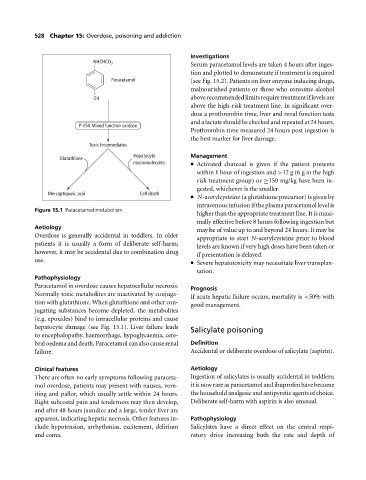Page 532 - Medicine and Surgery
P. 532
P1: KOA
BLUK007-15 BLUK007-Kendall May 12, 2005 20:54 Char Count= 0
528 Chapter 15: Overdose, poisoning and addiction
Investigations
NHCHCO 2 Serum paracetamol levels are taken 4 hours after inges-
tion and plotted to demonstrate if treatment is required
Paracetamol (see Fig. 15.2). Patients on liver enzyme inducing drugs,
malnourished patients or those who consume alcohol
OH aboverecommendedlimitsrequiretreatmentiflevelsare
above the high-risk treatment line. In significant over-
dose a prothrombin time, liver and renal function tests
and a lactate should be checked and repeated at 24 hours.
P-450 Mixed function oxidase
Prothrombin time measured 24 hours post ingestion is
the best marker for liver damage.
Toxic Intermediates
Hepatocyte Management
Glutathione
macromolecules Activated charcoal is given if the patient presents
within 1 hour of ingestion and >12 g (6 g in the high
risk treatment group) or ≥150 mg/kg have been in-
gested, whichever is the smaller.
Mercaptopuric acid Cell death
N-acetylcysteine (a glutathione precursor) is given by
intravenous infusion if the plasma paracetamol level is
Figure 15.1 Paracetamol metabolism.
higher than the appropriate treatment line. It is maxi-
mally effective before 8 hoursfollowing ingestion but
Aetiology
may be of value up to and beyond 24 hours. It may be
Overdose is generally accidental in toddlers. In older
appropriate to start N-acetylcysteine prior to blood
patients it is usually a form of deliberate self-harm;
levels are known if very high doses have been taken or
however, it may be accidental due to combination drug
if presentation is delayed.
use.
Severe hepatotoxicity may necessitate liver transplan-
tation.
Pathophysiology
Paracetamol in overdose causes hepatocellular necrosis.
Prognosis
Normally toxic metabolites are inactivated by conjuga-
If acute hepatic failure occurs, mortality is <50% with
tion with glutathione. When glutathione and other con-
good management.
jugating substances become depleted, the metabolites
(e.g. epoxides) bind to intracellular proteins and cause
hepatocyte damage (see Fig. 15.1). Liver failure leads Salicylate poisoning
to encephalopathy, haemorrhage, hypoglycaemia, cere-
bral oedema and death. Paracetamol can also cause renal Definition
failure. Accidental or deliberate overdose of salicylate (aspirin).
Clinical features Aetiology
There are often no early symptoms following paraceta- Ingestion of salicylates is usually accidental in toddlers;
mol overdose, patients may present with nausea, vom- it is now rare as paracetamol and ibuprofen have become
iting and pallor, which usually settle within 24 hours. the household analgesic and antipyretic agents of choice.
Right subcostal pain and tenderness may then develop, Deliberate self-harm with aspirin is also unusual.
and after 48 hours jaundice and a large, tender liver are
apparent, indicating hepatic necrosis. Other features in- Pathophysiology
clude hypotension, arrhythmias, excitement, delirium Salicylates have a direct effect on the central respi-
and coma. ratory drive increasing both the rate and depth of

